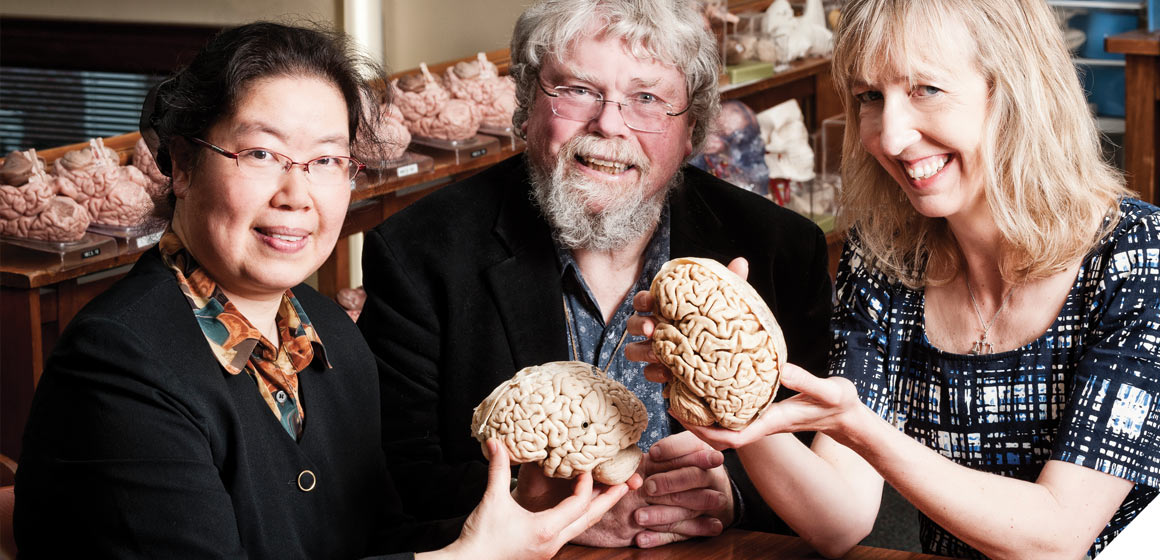
University of Otago researchers are at the forefront of identifying biomarkers of Alzheimer's disease – and new treatment options – that could lead to early diagnosis and better outcomes for the world's ageing population.
A recent international report on Alzheimer's disease predicts the number of dependent older people around the globe will rise from 101 million in 2010 to 277 million in 2050 – with nearly half living with Alzheimer's disease or another form of dementia. In 2011, the total financial cost of dementia in New Zealand was estimated at $950 million. Early diagnosis and better treatment options are key to managing this worldwide problem.
According to Biochemistry Professor Warren Tate, a recipient of New Zealand's highest science honour, the Rutherford Medal, in 2010, Alzheimer's disease diagnosis is complex and currently conclusive only at postmortem. So, being able to diagnose definitively much earlier – preferably before symptoms occur – would benefit patients enormously.
"Early diagnosis would give a chance for interventions to prevent the onset of the disease, or delay the symptoms from occurring. Knowing five, 10, even 20 years out, by identifying biomarkers in the blood that reveal the likelihood of an individual developing the disease, gives us time to treat this debilitating condition before memory loss and other symptoms occur."
Tate – a member of the University of Otago's Brain Health Research Centre led by Professor Cliff Abraham – is currently working on groundbreaking new research alongside Abraham, together with Dr Joanna Williams and Dr Ping Liu (Department of Anatomy), spearheading the identification of biomarkers to identify individuals at risk of developing the degenerative disease.
With the help of a Health Research Council grant of $4.75 million over five years, the team's preliminary results are promising – showing a range of biomarker effects, such as an increase in some molecules in samples from patients with Alzheimer's disease compared with matched healthy controls. Neuropsychologist Professor Bob Knight, neurologist Dr Nick Cutfield and pharmaceutical scientist Dr Hu Zhang are also important members of the research team.
"In 2008, it was discovered a particular class of RNA molecules, microRNA, is present in the blood and can reflect abnormalities in the body. We decided that this had enormous potential to provide early biomarkers of Alzheimer's disease," says Tate.
"We're hoping our research will be helpful in a number of ways – both in terms of indicators for early diagnosis and a different angle on treatment options."
"The results from Joanna Williams' group are extremely positive. We're trying to delay the symptoms from occurring and it's likely that the drugs currently used now may work better with early diagnosis. Ping Liu's group, by contrast, is examining changes in a particular class of blood metabolites that also have high promise to provide biomarkers."
More exciting still is that Tate and his team of biochemists are at the forefront of research into harnessing the power of protective molecules already found in the brain as a potential therapy for the disease.
Around the world, current treatment of the disease is looking towards blocking the "bad guys" (or the toxic aggregates of amyloid-ß) that are interfering with brain function in a brain affected by Alzheimer's disease. But leading the world in a new direction, Tate and his team are looking to engineer a "good guy" (a neuroprotective human brain protein) in the laboratory as a treatment for the affected brain. The protein, called sAPPa, is a secreted protein fragment derived from the same parent molecule as amyloid-ß, the pathological agent in Alzheimer's disease. sAPPa has neuroprotective and memory enhancing functions.
"We call it our Fonterra system. Basically, we are mimicking the brain in producing the 'good guy', but in engineered human cells in culture. We regularly 'milk' the culture media containing the secreted protein. Then we want to get it back into the brain.
"So far, the team has managed to inject this into the brains of lab animals whose memory mechanisms have been impaired and have restored normal function. Similarly, in behavioural tests we've been able to restore spatial memories that were lost. This molecule has the potential to restore memories. It's very exciting.
"We're hoping our research will be helpful in a number of ways – both in terms of indicators for early diagnosis and a different angle on treatment options.
"We're working closely with the Auckland Centre for Brain Research alongside other international groups to really make an impact on this crucial area of research. Our population is ageing and diseases such as Alzheimer's are going to affect more and more people."
Funding
- Health Research Council